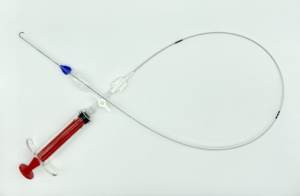
Front Line Medical Technologies has announced the expanded availability and distribution of COBRA-OS (Control of bleeding, resuscitation, arterial occlusion system), as US and Canadian hospitals continue to implement the aortic occlusion device during various surgical and emergency cases.
The COBRA-OS, which is approved by Health Canada and cleared by the U.S. Food and Drug Administration (FDA), is the first 4 French REBOA (resuscitative endovascular balloon occlusion of the aorta) device and has the lowest profile on the market, according to the company. The device is guidewire-free and has a 25mm diameter compliant balloon with a uniquely designed Safety Shoulder Reservoir incorporated into the device to help prevent aortic rupture during inflation. Despite being so small, the device is also strong enough to hold back aortic pressure and allows for permissive hypotension in bleeding areas below the balloon. The device can be deployed quickly, in just over a minute, which is key in emergency situations.
In addition to permitting interventional radiologists the time to perform internal iliac artery embolisation in hypotensive patients with unstable traumatic pelvic fractures, the COBRA-OS has been recently used prophylactically to treat a pregnant patient with placenta accreta, significantly reducing the risk to both mother and child.
Adam Power (Victoria Hospital in London, Ontario, Canada), vascular surgeon and co-inventor of the COBRA-OS, has successfully utilized the device with his interventional radiology colleagues in traumatic bleeding cases to help stabilise patients. As the device is so low profile, he has even been contacted to help with pediatric patients with uncontrolled bleeding.
“The COBRA-OS is a versatile tool that can be a swiss army knife for interventionalists. There is no other compliant balloon medical device in the world that goes through a 4 French sheath and can expand to 25mm diameter. I’ve even seen it be used coaxially in larger sheaths to occlude the aorta and allow interventions through the same single sheath which was pretty impressive,” said Power. “Access site complications are the bane of my existence as a vascular surgeon and I want to help lower their incidence, especially in extremely sick patients.”













